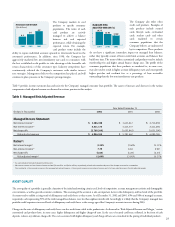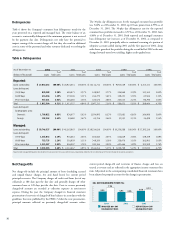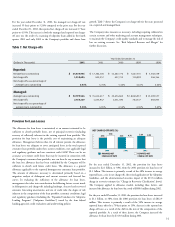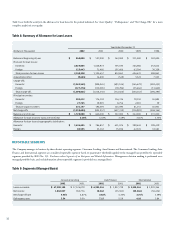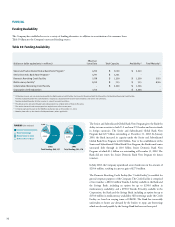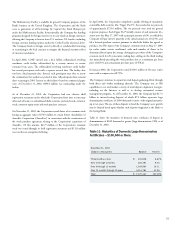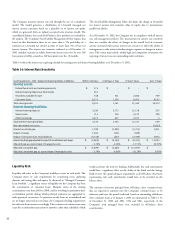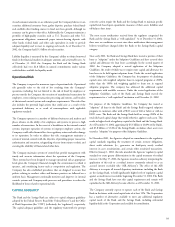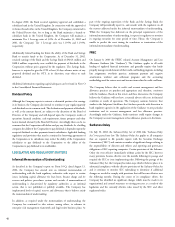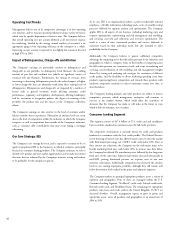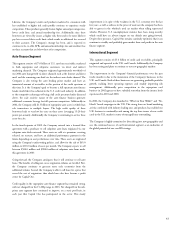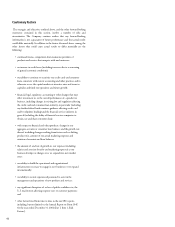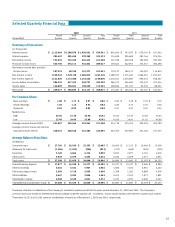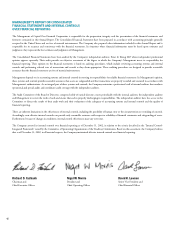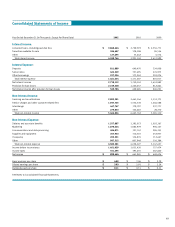Capital One 2002 Annual Report Download - page 41
Download and view the complete annual report
Please find page 41 of the 2002 Capital One annual report below. You can navigate through the pages in the report by either clicking on the pages listed below, or by using the keyword search tool below to find specific information within the annual report.
39
corrective action require the Bank and the Savings Bank to maintain specific
capital levels based upon quantitative measures of their assets, liabilities and
off-balance sheet items.
The most recent notifications received from the regulators categorized the
Bank and the Savings Bank as “well-capitalized.” As of December 31, 2002,
there were no conditions or events since these notifications that management
believes would have changed either the Bank or the Savings Bank’s capital
category.
Since early 2001, the Bank and Savings Bank have treated a portion of their
loans as “subprime” under the Subprime Guidelines and have assessed their
capital and allowance for loan losses accordingly. In the second quarter of
2002, the Company adopted a revised application of the Subprime
Guidelines, the result of which was to require more capital and allowance for
loan losses to be held against subprime loans. Under the revised application
of the Subprime Guidelines, the Company has, for purposes of calculating
capital ratios, risk weighted subprime loans in targeted programs at 200%,
rather than the 100% risk weighting applied to loans not in targeted
subprime programs. The company has addressed the additional capital
requirements with available resources. Under the revised application of the
Subprime Guidelines, each of the Bank and Savings Bank exceeds the
requirements for a “well-capitalized” institution as of December 31, 2002.
For purposes of the Subprime Guidelines, the Company has treated as
“subprime” all loans in the Bank’s and the Savings Bank’s targeted subprime
programs to customers either with a FICO score of 660 or below or with no
FICO score. The Bank and the Savings Bank hold on average 200% of the
total risk-based capital charge that would otherwise apply to such assets. This
results in higher levels of regulatory capital at the Bank and the Savings Bank.
As of December 31, 2002, approximately $5.3 billion or 28.0% of the Bank’s,
and $3.8 billion or 32.4% of the Savings Bank’s, on-balance sheet assets were
treated as “subprime” for purposes of the Subprime Guidelines.
In November 2001, the Agencies adopted an amendment to the regulatory
capital standards regarding the treatment of certain recourse obligations,
direct credit substitutes (i.e., guarantees on third-party assets), residual
interests in asset securitizations, and certain other securitized transactions.
Effective January 1, 2002, this rule amended the Agencies’ regulatory capital
standards to create greater differentiation in the capital treatment of residual
interests. On May 17, 2002, the Agencies issued an advisory interpreting the
application of this rule to a residual interest commonly referred to as an
accrued interest receivable (the “AIR Advisory”). The effect of this AIR
Advisory is to require all insured depository institutions, including the Bank
an the Savings Bank, to hold significantly higher levels of regulatory capital
against accrued interest receivables beginning December 31, 2002. The Bank
and the Savings Bank have met this capital requirement and remain well
capitalized as the AIR Advisory became effective as of December 31, 2002.
The Company currently expects to operate each of the Bank and Savings
Bank in the future with a total capital ratio of at least 12%. The Corporation
has a number of alternatives available to meet any additional regulatory
capital needs of the Bank and the Savings Bank, including substantial
liquidity held at the Corporation and available for contribution.
As such amounts amortize or are otherwise paid, the Company believes it can
securitize additional consumer loans, gather deposits, purchase federal funds
and establish other funding sources to fund new loan growth, although no
assurance can be given to that effect. Additionally, the Company maintains a
portfolio of high-quality securities such as U.S. Treasuries and other U.S.
government obligations, commercial paper, interest-bearing deposits with
other banks, federal funds and other cash equivalents in order to provide
adequate liquidity and to meet its ongoing cash needs. As of December 31,
2002, the Company had $5.3 billion of such securities.
Liability liquidity is measured by the Company’s ability to obtain borrowed
funds in the financial markets in adequate amounts and at favorable rates. As
of December 31, 2002, the Company, the Bank and the Savings Bank
collectively had over $2.8 billion in unused commitments under various
credit facilities available for liquidity needs.
Operational Risk
The Company is exposed to numerous types of operational risk. Operational
risk generally refers to the risk of loss resulting from the Company’s
operations, including, but not limited to, the risk of fraud by employees or
persons outside the Company, the execution of unauthorized transactions by
employees, errors relating to transaction processing and systems, and breaches
of the internal control, system and compliance requirements. This risk of loss
also includes the potential legal actions that could arise as a result of the
operational deficiency or as result of noncompliance with applicable
regulatory standards.
The Company operates in a number of different businesses and markets and
places reliance on the ability of its employees and systems to process a high
number of transactions. In the event of a breakdown in the internal control
systems, improper operation of systems or improper employee actions, the
Company could suffer financial loss, face regulatory action and suffer damage
to its reputation. In order to address this risk, management maintains a
system of internal controls with the objective of providing proper transaction
authorization and execution, safeguarding of assets from misuse or theft, and
ensuring the reliability of financial and other data.
The Company maintains systems of control that provide management with
timely and accurate information about the operations of the Company.
These systems have been designed to manage operational risk at appropriate
levels given the Company’s financial strength, the environment in which it
operates, and considering factors such as competition and regulation. The
Company has also established procedures that are designed to ensure that
policies relating to conduct, ethics and business practices are followed on a
uniform basis. Management continually monitors and improves its internal
controls systems and Company-wide processes and procedures to reduce the
likelihood of losses related to operational risk.
CAPITAL ADEQUACY
The Bank and the Savings Bank are subject to capital adequacy guidelines
adopted by the Federal Reserve Board (the “Federal Reserve”) and the Office
of Thrift Supervision (the “OTS”) (collectively, the “regulators”), respectively.
The capital adequacy guidelines and the regulatory framework for prompt


